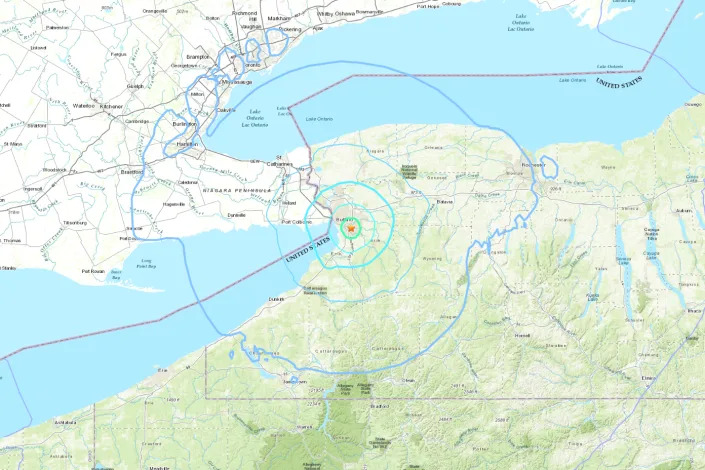FELT IN CANADA
Buffalo, New York, area is hit with the strongest earthquake in 40 years
USGS
Marlene Lenthang and Colin Sheeley
Mon, February 6, 2023
A 3.8-magnitude earthquake struck Monday morning near Buffalo, New York, the strongest recorded in the area in 40 years.
The quake hit 1.24 miles east-northeast of West Seneca, New York, with a depth of 1.86 miles, around 6:15 a.m., according to the U.S. Geological Survey.
Erie County Executive Mark Poloncarz said no damage had been reported so far in West Seneca, a suburb of Buffalo near the U.S.-Canada border.
He said he had spoken with the deputy commissioner of the Erie County Department of Homeland Security and Emergency Services, Gregory J. Butcher, who said a “confirmed quake was felt as far north as Niagara Falls and south to Orchard Park.”
“It felt like a car hit my house in Buffalo. I jumped out of bed,” Poloncarz said.
Yaareb Altaweel, a seismologist at the National Earthquake Information Center, said Northeast earthquakes “happen all the time” and quakes can strike anywhere at any time.
Since 1983, there have been 24 earthquakes above magnitude 2.5 in the West Seneca region, with Monday’s being the largest so far in the area.
Altaweel said another 3.8-magnitude quake took place in 1999 in western New York.
“On a scale of earthquakes, 3.8 isn’t that big. But the crust in that region is old crust. It’s old and cold, and the efficiency of transferring the seismic waves versus sedimentary areas — that’s why people can feel it more. That’s why earthquakes can be felt even at 1.0 in some places,” he said.
Altaweel said a 3.8-magnitude quake is “not a big earthquake that you’d expect damage from.”
Existing fractures and fault lines can cause earthquakes to hit so far inland, he said.
Altaweel said there was nothing abnormal about this shock.
“I’d say it’s very normal. There was one, a 2.6, in March 2022. There was another 2 in 2020. These keep happening in this region at low magnitude,” he said.
Around the globe, an initial 7.8-magnitude earthquake in southeastern Turkey was followed hours later by a 7.5-magnitude quake that shook buildings and killed more than 3,600 people in the country and neighboring Syria. The toll is expected to rise sharply on both sides of the border.
This article was originally published on NBCNews.com
4.2 magnitude earthquake felt in Ontario largest to hit Buffalo area in decades
Mon, February 6, 2023

A 4.2 magnitude earthquake was "lightly felt" in Ontario after it hit near Buffalo, N.Y., Earthquakes Canada said Monday – a light quake by international measures but the largest to hit the area in more than a half-century.
No significant damage was reported in the hours after Monday morning's earthquake and none would be expected to accompany one of its size, said Stephen Halchuk, a seismologist with Natural Resources Canada.
A search of recorded seismic activity within 100 kilometres showed the last one to measure higher on the Richter scale was 4.5 magnitude in 1967 near Buffalo, Halchuk said.
"It is larger than we would normally see," he said.
The earthquake was reported at 6:15 a.m. and pinpointed around six kilometres east of Buffalo. The U.S. Geological Survey measured it slightly lower at 3.8.
Just across the U.S.-Canada border in Fort Erie, Ont., Mayor Wayne Redekop said he was stirred awake by the sound of the earthquake's rumble. His house shook, but everything stayed on the shelves, he said.
"It was fairly mild, but it was definitely noticeable," he said.
Redekop said he exchanged texts with his two daughters who also live in town and they told him they also felt their homes shake.
"It was a sufficient magnitude that it woke everybody up except my youngest grandson, who apparently slept right through it," Redekop said. "But he's four. He probably ran the batteries down yesterday and needed to recharge."
The area, referred to by seismologists as the Niagara-Attica zone, sees regular activity, with records indicating about 60 earthquakes in the past decade, Halchuk said. But the vast majority have been magnitude two or smaller – too small to be felt.
The zone is far from North American tectonic plate boundaries in the middle of the Atlantic Ocean and in the Caribbean Sea. But as the plate crawls along, at a pace of around five to ten centimetres a year, stresses build up in the earth's crust, leading to "areas of weakness", such as the Niagara-Attica zone, Halchuk said.
"You get these stresses being released in the form of these small earthquakes that occur occasionally in the region," he said, noting there's no reason to expect more frequent earthquakes.
The quake came on the same day as a major 7.8 magnitude earthquake rocked large parts of Turkey and Syria, toppling buildings and killing thousands. Halchuk said Turkey lies near an intersection of three tectonic plates, creating high seismic activity and the potential for large damaging earthquakes.
In the Niagara-Attica zone, the largest earthquake ever recorded was a 4.9 magnitude quake in 1929 near Attica, N.Y., which caused only moderate damage, according to the U.S. Geological Survey.
This report by The Canadian Press was first published Feb. 6, 2023.
Jordan Omstead, The Canadian Press
Mon, February 6, 2023

A 4.2 magnitude earthquake was "lightly felt" in Ontario after it hit near Buffalo, N.Y., Earthquakes Canada said Monday – a light quake by international measures but the largest to hit the area in more than a half-century.
No significant damage was reported in the hours after Monday morning's earthquake and none would be expected to accompany one of its size, said Stephen Halchuk, a seismologist with Natural Resources Canada.
A search of recorded seismic activity within 100 kilometres showed the last one to measure higher on the Richter scale was 4.5 magnitude in 1967 near Buffalo, Halchuk said.
"It is larger than we would normally see," he said.
The earthquake was reported at 6:15 a.m. and pinpointed around six kilometres east of Buffalo. The U.S. Geological Survey measured it slightly lower at 3.8.
Just across the U.S.-Canada border in Fort Erie, Ont., Mayor Wayne Redekop said he was stirred awake by the sound of the earthquake's rumble. His house shook, but everything stayed on the shelves, he said.
"It was fairly mild, but it was definitely noticeable," he said.
Redekop said he exchanged texts with his two daughters who also live in town and they told him they also felt their homes shake.
"It was a sufficient magnitude that it woke everybody up except my youngest grandson, who apparently slept right through it," Redekop said. "But he's four. He probably ran the batteries down yesterday and needed to recharge."
The area, referred to by seismologists as the Niagara-Attica zone, sees regular activity, with records indicating about 60 earthquakes in the past decade, Halchuk said. But the vast majority have been magnitude two or smaller – too small to be felt.
The zone is far from North American tectonic plate boundaries in the middle of the Atlantic Ocean and in the Caribbean Sea. But as the plate crawls along, at a pace of around five to ten centimetres a year, stresses build up in the earth's crust, leading to "areas of weakness", such as the Niagara-Attica zone, Halchuk said.
"You get these stresses being released in the form of these small earthquakes that occur occasionally in the region," he said, noting there's no reason to expect more frequent earthquakes.
The quake came on the same day as a major 7.8 magnitude earthquake rocked large parts of Turkey and Syria, toppling buildings and killing thousands. Halchuk said Turkey lies near an intersection of three tectonic plates, creating high seismic activity and the potential for large damaging earthquakes.
In the Niagara-Attica zone, the largest earthquake ever recorded was a 4.9 magnitude quake in 1929 near Attica, N.Y., which caused only moderate damage, according to the U.S. Geological Survey.
This report by The Canadian Press was first published Feb. 6, 2023.
Jordan Omstead, The Canadian Press
No comments:
Post a Comment